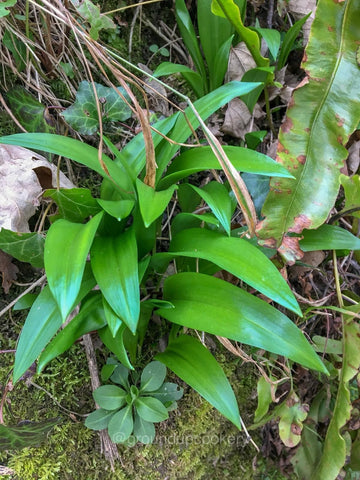
Wild Garlic
Eagerly awaited, wild garlic season is back in full swing!
The great thing about seasonal food is that you can eat so much of it that you never want to see it again, but by the time the season returns we can't wait to start all over!
One of the most widely harvested and easily recognisable wild plants Wild Garlic, Allium Ursinum, is a wonderful, tasty and easy to cook plant that can be utilised in so many different ways. Its short season and bountifulness make it a great plant as an introduction to foraging enforcing the very idea of local and seasonal food.

This part of Devon has its own micro climate, being just on the Northern edge of Dartmoor’s has a dramatic effect on our seasons. When the wild garlic was only just beginning to show here I drove to Dartmouth, my old home town, to harvest my first batch down at the beautiful Old Mill Creek. We didn’t want to wait as we had a stall at the fabulously popular Exeter Vegan Market and I wanted to make a vegan pesto to sell there.
To make vegan pesto I substitute parmesan for nutritional yeast, a great product that mimics the salty, umami cheese flavour very well. I also don’t tend to use pine nuts in my pesto either. Sunflower seeds, roasted or not, give the same texture and a similar taste making the pesto accessible to many people who otherwise couldn’t share such a delightful product.
Of course, Wild Garlic is a wild plant, you need to be careful where you pick it, what you could pick with it and clean it well. Don’t pick next to busy roads to avoid pollutants. Watch out for the succulent spear shaped leaves of Arum Maculatum (Lords and Ladies or Cuckoo Pint) which when young can easily be mistaken for Wild Garlic.This plant is toxic and eating can prove fatal.
There are many other fabulous ways to utilise Wild Garlic. I love to lacto ferment it for a year, it has a remarkable flavour and you can join us to taste it at our upcoming Introduction to Fermented Food & Drinks course on the 27th April, just search in “courses” on our website www.groundupcookeryschool.co.uk to book a place.
We also use Wild Garlic like spinach, it's great in frittata, potato cakes, scrambled eggs, pasta sauces and simply as wilted green vegetable, particularly with fish.
The flower buds also make great eating, raw they add a wonderful oniony crisp bite to a salad or pasta dish although my favourite way to use them is simply layering with salt, pressing in a jar and ageing them for around six months, a similar process to making capers. What you end up with are delicately smoky tasting, lightly crisp and gently garlicky flavoured pods that are so good you can eat them on their own.
We also dry the leaves, grind them with coarse sea salt to make a rub, use the flowers fresh in salads, sandwiches and to finish dishes, dry the flowers to use in pasta sauces or soup. Pickling the buds in cider vinegar is also nice, very crispy and sharp, a great food to pair with a rich pate or a strong cheese.
Here are a few examples photographed, front left is dried leaves, behind is wild garlic salt, back right is lacto fermented leaves, middle is wild garlic capers and in the front we have the pickled flower buds.

